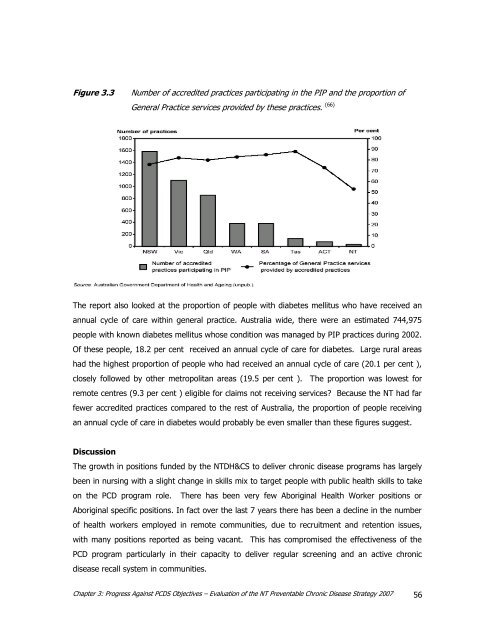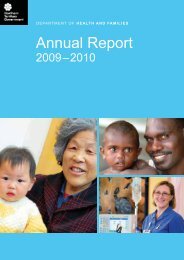PCD Strategy Evaluation 2007.pdf - NT Health Digital Library ...
PCD Strategy Evaluation 2007.pdf - NT Health Digital Library ...
PCD Strategy Evaluation 2007.pdf - NT Health Digital Library ...
Create successful ePaper yourself
Turn your PDF publications into a flip-book with our unique Google optimized e-Paper software.
Figure 3.3Number of accredited practices participating in the PIP and the proportion ofGeneral Practice services provided by these practices. (66)The report also looked at the proportion of people with diabetes mellitus who have received anannual cycle of care within general practice. Australia wide, there were an estimated 744,975people with known diabetes mellitus whose condition was managed by PIP practices during 2002.Of these people, 18.2 per cent received an annual cycle of care for diabetes. Large rural areashad the highest proportion of people who had received an annual cycle of care (20.1 per cent ),closely followed by other metropolitan areas (19.5 per cent ). The proportion was lowest forremote centres (9.3 per cent ) eligible for claims not receiving services? Because the <strong>NT</strong> had farfewer accredited practices compared to the rest of Australia, the proportion of people receivingan annual cycle of care in diabetes would probably be even smaller than these figures suggest.DiscussionThe growth in positions funded by the <strong>NT</strong>DH&CS to deliver chronic disease programs has largelybeen in nursing with a slight change in skills mix to target people with public health skills to takeon the <strong>PCD</strong> program role. There has been very few Aboriginal <strong>Health</strong> Worker positions orAboriginal specific positions. In fact over the last 7 years there has been a decline in the numberof health workers employed in remote communities, due to recruitment and retention issues,with many positions reported as being vacant. This has compromised the effectiveness of the<strong>PCD</strong> program particularly in their capacity to deliver regular screening and an active chronicdisease recall system in communities.Chapter 3: Progress Against <strong>PCD</strong>S Objectives – <strong>Evaluation</strong> of the <strong>NT</strong> Preventable Chronic Disease <strong>Strategy</strong> 2007 56
















